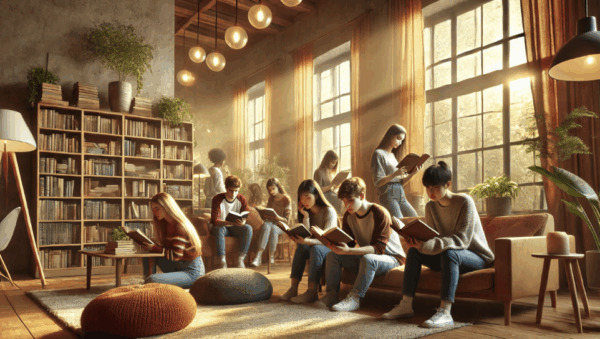Ever noticed how every romance novel seems to have that perfect “meet-cute” moment? You know the one: two characters accidentally bump into each other, spill coffee, exchange awkward smiles, and suddenly, the sparks fly. It’s a scene so common you could almost set your watch to it. But guess what? That meet-cute is no accident—it’s a genre convention, and it’s there for a reason.
So, what are genre conventions, exactly? Simply put, they’re the unwritten rules that guide the way stories in a particular genre are told. Whether it’s a mystery novel always featuring a quirky detective or a horror film making sure there’s a creepy, isolated cabin in the woods, genre conventions are the building blocks that set expectations for readers and viewers alike. These conventions help create a familiar framework that lets the audience know what kind of experience they’re about to have. It’s like walking into a bakery and knowing you’ll find delicious pastries, even if you’re not sure exactly which one yet.
In this article, we’re going to peel back the curtain on genre conventions. We’ll explore what they are, why they exist, and how they shape both the writing process and the reader’s experience. By the end, you’ll have a solid understanding of how these secret rules can make stories more engaging while also giving writers the creative freedom to tweak and bend those rules in clever ways.
What Are Genre Conventions?
Genre conventions are like the unspoken rules of the storytelling game. They’re the familiar patterns, tropes, and themes that readers expect when they pick up a book or watch a film in a specific genre. These conventions aren’t written in stone—they’re just the expectations that come with the territory. When you grab a romance novel, for example, you’re probably anticipating a love story with a happy ending. In a thriller, you’re likely expecting a fast-paced narrative filled with twists and danger. These patterns are what help the genre feel cohesive and familiar while also guiding the reader through the experience.
But conventions do more than just provide comfort—they help shape the entire structure of a story. They act as a kind of framework, giving writers a starting point for their narrative and allowing them to focus on creativity within those boundaries. When readers dive into a genre, they know the type of emotional or intellectual journey they’re in for. A well-placed convention doesn’t just meet their expectations—it enhances the experience.
Take the romance genre, for example. A common convention is the love triangle—a plot device where the protagonist is torn between two potential romantic partners. It’s practically a rite of passage in the genre! While this plot might seem predictable, it’s the emotional tension and development within this framework that keeps readers hooked. Even though we know what’s coming, the joy is in how the story unfolds within that structure.
The Genre Conventions Definition: A Deeper Dive
At their core, genre conventions are the patterns, themes, and tropes that define a specific genre. Think of them as the basic building blocks that make a genre what it is—like the must-have ingredients in a dish. In a fantasy novel, it’s dragons and magical quests; in a mystery, it’s the detective and the crime. These conventions provide a sense of structure and familiarity, helping the reader understand the kind of story they’re about to embark on.
But let’s be clear: genre conventions aren’t the same as clichés. Conventions are the tried-and-true elements that keep a genre grounded, while clichés are the tired, overused versions of those elements that often feel stale or lazy. It’s the difference between a detective with a tragic backstory (a convention) and a detective who’s so brooding and haunted by the past that they make Batman look cheerful (a cliché). The former adds depth to the character, the latter makes you roll your eyes and sigh.
Take a classic whodunit, for example. A good mystery novel will introduce the detective, set up the crime, and keep readers guessing until the end. That’s a convention. But if every character in the book happens to be “mysterious” and constantly dropping cryptic one-liners, you’ve crossed into cliché territory. The key? Use conventions wisely, and avoid beating them to death.
What Are Genre Conventions in Writing? The Backbone of Your Story
For writers, genre conventions aren’t just helpful—they’re essential. They serve as the blueprint that shapes your narrative and gives your readers exactly what they came for: a story that feels like home, even when it surprises them. Whether you’re crafting a dystopian adventure or a cozy mystery, these conventions anchor your work in its genre and help ensure it hits all the right notes for your target audience.
But here’s the trick: Genre conventions should guide your storytelling, not strangle it. Don’t lean so hard on familiar tropes that your plot becomes a paint-by-numbers project. Instead, treat conventions like trusted landmarks on your story’s journey—recognizable and comforting, but open to creative rerouting. Give readers what they expect, but add your unique twist to keep things fresh and memorable.
A few quick tips: Know your genre inside and out. Read widely within it to understand what readers love—and what they’re tired of. Use conventions as a foundation, but don’t be afraid to subvert them when it serves the story. And above all, keep your voice original.
Writers, think of genre conventions as the GPS guiding your readers to the destination they expect—but with a few surprise detours along the way.
Genre Conventions Examples: From the Obvious to the Subtle
Let’s be honest—genre conventions can be as obvious as a love story ending with a kiss in the rain or as subtle as a wizard muttering Latin-ish spells. Still, whether they shout or whisper, they’re the magic behind why we keep coming back to certain genres.
In romance, it’s all about that “happily ever after.” Readers expect emotional payoff, resolution, and yes, a relationship that’s finally figured itself out. No one wants to invest in 300 pages of longing only to have the couple call it quits over brunch.
Mystery thrives on the sleuth who just can’t let it go. Whether it’s a grizzled PI or an amateur with a knack for sniffing out secrets, the convention of the compulsively curious detective is what keeps us hooked until the big reveal.
Fantasy often sticks to the hero’s journey: a chosen one, a magical world, and a destiny they can’t escape (even if they’d really rather stay home). Throw in a talking sword or two, and you’re golden.
Science fiction loves tech—either wildly advanced or dangerously broken. Dystopian futures, space operas, rogue AI… It’s all part of the genre’s DNA.
Sure, these conventions can get predictable. But that’s the point—they give readers what they came for. And when writers add a twist? That’s when conventions go from expected to unforgettable.
Why Do Genre Conventions Matter to Readers?
Genre conventions matter because they’re the literary equivalent of comfort food—they let readers settle in, relax, and trust that they’re in for a familiar, satisfying ride. When you pick up a fantasy novel, you don’t want to spend ten chapters wondering whether the glowing sword actually means something. You expect magic. You expect quests. And you’re not mad about it.
Conventions help set the tone and emotional expectations of a story. A horror novel should give you that eerie, skin-crawling tension. A rom-com should leave you smiling and maybe snorting into your coffee. These genre-specific signals act as guideposts, gently nudging the reader toward the experience they signed up for.
And then there’s the payoff. Conventions don’t just set the stage—they deliver the satisfaction. In a mystery, readers want to be led through a maze of clues, only to have the final piece snap into place at the end. In sci-fi, they want their minds blown by a bold vision of the future. Conventions ensure the journey—and the destination—live up to expectations.
Now imagine reading a romance novel where the couple never meets. No “meet-cute,” no romantic tension, just two people living separate lives and occasionally texting about their cats. Feels weird, right? That’s the absence of a key convention—and proof that these narrative staples aren’t just helpful, they’re essential. Without them, the story loses its genre identity, and readers are left wondering, What did I just read?
How Do Genre Conventions Help Readers Know What to Expect?
Genre conventions act like literary signposts, guiding readers through familiar territory. They set the tone, hint at the structure, and help readers immediately recognize whether they’re in for a laugh, a scare, a swoon, or a puzzle. From eerie fog in horror to swoony glances in romance, these cues quietly whisper, “You’ve been here before—and you liked it.”
Think of genre conventions as that savvy friend who texts you before a party to say, “Dress nice, it’s fancy,” or “Bring snacks, it’s a movie marathon.” They don’t just tell you where you are—they help you enjoy the ride.
Master the Conventions, Play with the Expectations
Understanding genre conventions is like getting the cheat codes to storytelling—they don’t write the story for you, but they definitely help you play smarter. For readers, these conventions offer comfort, clarity, and satisfaction. For writers, they’re a creative launchpad, providing structure while still leaving plenty of room to innovate.
The real magic happens when you know the rules well enough to bend them. Subverting expectations—like flipping a romance’s “happily ever after” into something bittersweet or making the villain in a mystery the narrator all along—keeps your story fresh, surprising, and delightfully unforgettable. Genre conventions should never be a creative cage. Think of them more like a dance floor: the steps are there, but how you groove is up to you.
So whether you’re writing your next big novel or binge-reading your favorite genre, start paying attention to the patterns. Notice how they shape your experience and how they shift when a writer dares to take a creative leap.
Explore different genres. Spot the conventions. And when you’re ready, twist them into something that’s uniquely yours. Because knowing the rules is great—but knowing when to break them? That’s storytelling gold.
FAQs – Genre Conventions
Q1: How do you identify genre conventions?
To identify genre conventions, look for recurring elements—like themes, settings, character types, plot structures, or stylistic choices—that commonly appear in works within the same genre. For example, a murder to solve in a mystery or a hero’s journey in fantasy. Reading widely in a genre helps spot these patterns. Think of conventions as the DNA of the genre—they might not all be present, but their presence helps you recognize what kind of story you’re in.
Q2: What are the genre conventions of the media?
In media, genre conventions refer to the standard features and stylistic choices that help define categories like film, television, or digital content. For instance, horror films often include eerie music, low lighting, and a sense of suspense, while romantic comedies feature meet-cutes, lighthearted tones, and happy endings. These conventions help audiences immediately recognize and engage with the media content.
Q3: What are the genre conventions in sci-fi?
Science fiction conventions often include futuristic settings, advanced technology, space travel, alien species, and exploration of societal issues through speculative lenses. Common themes involve AI, dystopias, time travel, or scientific breakthroughs. These elements aren’t required, but they’re frequently used to frame the “what if” questions that drive sci-fi narratives.
Q4: What are genre conventions in rhetoric?
In rhetoric, genre conventions refer to the expected structure, tone, and content of communication in specific contexts—like essays, speeches, or opinion pieces. For example, a persuasive essay conventionally includes a thesis statement, supporting arguments, and a conclusion. Understanding these conventions helps writers tailor their message for their audience and purpose.
Q5: What are status genre conventions?
Status genre conventions refer to the narrative structures and expectations related to stories about social mobility, personal success, or failure. These are often seen in genres like dramas or coming-of-age stories. Common conventions include a protagonist striving for recognition, encountering trials, and either rising in status or facing consequences. It’s all about navigating personal or societal hierarchies.
Q6: What are the 7 genres of literature and examples?
The 7 commonly recognized genres of literature are:
- Fiction – e.g., To Kill a Mockingbird by Harper Lee
- Nonfiction – e.g., Educated by Tara Westover
- Poetry – e.g., The Raven by Edgar Allan Poe
- Drama – e.g., Romeo and Juliet by William Shakespeare
- Folklore – e.g., The Brothers Grimm Fairy Tales
- Fantasy – e.g., Harry Potter series
- Science Fiction – e.g., Dune by Frank Herbert
Each genre has its own conventions, but they often overlap and evolve with time.









